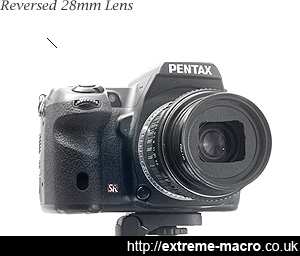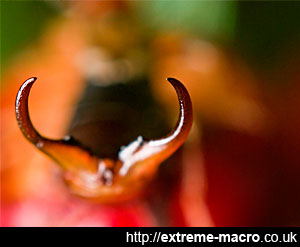Single Reverse Lens Macro
by Johan J Ingles-Le Nobel
Last updated August 31, 2017
Reversing a single lens to gain the magnification necessary for extreme macro photography is a good start, but in order to avoid vignetting it's best done in conjunction with extension tubes or a set of bellows.

Pentax K series 28mm lens reversed, a great way to do macro without a macro lens, but much less convenient than using a raynox diopter because you lose in-body aperture setting. Remember, you're not using the regular camera mount end, so the brand of the reversed lens really doesn't matter. Note the use of use the endcap that came with the lens as a custom hood, this is highly advised as it helps keep the levels where they should be.
Compared to the other reversed lens technique of coupled reverse lenses, it requires a different adapter.
Reversing Ring
A reversing ring is the adapter you need; it allows you to reverse a single lens straight onto a camera mount, be it on a body, bellows or extension tubes. One side of the reversing ring has a lens mount, the other side has filter threads.
It can be confusing, but a reversing ring goes by various names and descriptions. This includes reversing ring, reverse ring, reverse adapter and reverse lens adapter: they all do the same, have a lens mount that goes into your camera and a filter thread on the other side so that you can attach a lens in reverse.
Reversing Old Manual Prime Lenses

Alarmed earwig trying to frighten me, shot at night, shot using a reversed 50mm lens. Great fun and produces excellent results using old vintage lenses which are cheap as chips.
Hunt around on eBay for used old full frame 35mm lenses with aperture rings in the 35-50mm range, avoid any with fungus, and for as little as £10 you can be on your way with extreme macro.
But reversed lenses are rather tricky to use so consider learning techniques with a Raynox first.
I use 50mm and 28mm reversed myself: 50mm is significantly easier to use than 28mm especially if the lens is stopped down to f/8 to gain a bit of depth of field.
A standard 'kit' 50mm Pentax-a f/1.7 is perfectly good for macro although the result is better with reversed enlarger lenses or even a reversed 50mm Pentax-m f/4 macro lenses in terms of resolution.
The reason I mention Pentax here is because these lenses are all reversed, so actually it doesn't matter what brand you use for the reversed lens because the mount does not matter (it's reversed, not using the mount). And there's plenty of old Pentax glass about. Old lenses are better than modern lenses, as they have manual f/stops.
The standard f1./7 50mm lens does give more chromatic aberration than some others, and is not as contrasty as some of the more modern reversed enlarger lenses. But they're cheap to buy, and are a great way into extreme macro.
Make A Lens Hood
The performance of reversed older manual lenses can be improved by making a custom hood. There are all sorts of ways to do this but I found that an old soft plastic endcap with an appropriate hole cut into it makes for a great hood.
A hood increases contrast because there's less light bouncing around inside, so less of a mundane greyness throughout the image.
Magnification
The performance of reversed older manual lenses can be improved by making a custom hoodI have not personally come across a practical formula for working out the magnification of a single reversed lens, either on its own or on bellows.
Technically you need to know the distance from the relevant principal plane of the lens to the sensor which is not usually published information.
Protecting The Reversed Lens
Once mounted in reverse, you will see some of the mechanics of your lens that are normally not exposed. All of the pins the lens uses to talk with the camera are visible as well as the internal glass element that moves in and out when focusing.
Leaving a lens on in reverse can let dust inside your lens so I use the endcap that came with the lens as a lenscap. Cheap, fits, and works perfectly.

Reversed lens formula, where F is the focal length in mm, S1 is the distance from the lens' optical centre to subject and S2 is the distance from the lens' optical centre to sensor.
What Lens Can You Reverse?
It isn't possible to reverse every lens, especially if they are a very wide angle or a telephoto zoom. I've had success myself reversing 24mm up to 50mm (beyond 50mm there is no point) but fish eye/wide angle lenses don't seem to give great results, partially because the magnification is so large and partially because lighting tends to become very problematic. Your best bet if you just want to have a go is to find some old 28-50mm fullframe lens which has a manual aperture ring, and buy the neccessary reversal equipment. If you have vignetting on the final shot then try adding some extension tubing into the mix.
Is there a Best Focal Length for Reverse Lens Macro?
There is no best focal length for reverse macro: 28mm-50mm are the most commonly used because they tend to give the magnifications that people like. The magnification is very simple: 50mm reversed 5 cm away from the sensor will give 1:1 (50/50, and 28mm 7.5 cm away from the sensor will give approximately 3:1 (74/28). It is harder to focus at greater magnifications: a 50 reversed is usually a good first buy as sets of extension tubes are typically up to 80mm or so, and a reversed 50 will let you get into greater than 1:1. After maxxing out on tubes (or use a couple of sets together), use bellows.
Reversed Lens Macro Formula
The formula for reversed lenses is 1/S1 + 1/S2 = 1/F
All in mm, S1 is distance from object to the lens' optical centre, S2 is distance from the lens' optical centre to the camera sensor, and F is focal length. To find the sensor distance, there is usually a stripe marked on top of your DSLR which shows where the sensor plane is.
Bear in mind that this is actually a theoretical formula for an infinitely thin lens, but works fine in practice for traditional focusing lenses.
For complex zoom lenses and inner focus lenses it is less accurate.
The Downside
Reverse lenses are a fun way to get into extreme macro, but there is a definite downside to using these. Typically your camera will not be able to communicate with the reversed lens, which means that camera features such as being able to set the aperture in the camera and autofocus are not available. The former can be especially trying, because if you want to use your reversed lens at f/8 it means you need to look through the camera and focus at f/8... and f/8 makes for a very dark viewfinder. Adding a torch to brighten up what you see is one strategy that's used, but beyond that there is no quick and simple fix.
Reversed vs. Macro Lens
A question that I've seen asked is comparing the quality of a reversed lens and a macro lens. In a sense it is the wrong question because they're not generally the same thing: a consumer macro lens is usually up to 1:1 whereas a reversed lens is usually used in the 1:1 to 5:1 range. So it's not so much a case of being better as it is a case of being different. That said though, reversed lenses on their own, whilst a great introduction into macro, do not generally perform as well as a coupled reverse lens, especially in the corners.
Related Articles





